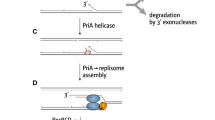Summary
Recombination in vivo was studied in recA - heterozygous lacZ merodiploids by performing β-galactosidase assays after infection with λprecA +. Recombination as measured by β-galactosidase production was a linear function of λpecA + multiplicity of infection (MOI) when the strain contained a deletion of the chromosomal recA gene. However, when the strain carried a recA1 missense allele, a higher λprecA + MOI was required to obtain levels of recombination comparable to the Δ(recA) strain, and the slope of the dose-response curve increased to approximately two. It is proposed that negative complementation occurs in mixed tetramers of wild-type and missense recA polypeptides, and that in vivo recombination is a property of a multimeric form of recA protein.
Similar content being viewed by others
References
Bachmann B (1972) Pedigrees of some mutant strains of Escherichia coli K-12. Bacteriol Rev 36:525–557
Birge EA, Low KB (1974) Detection of transcribable recombination products following conjugation in Rec+, RecB- and RecC- strains of Escherichia coli K-12. J Mol Biol 83:447–457
Charette MF, Henderson GW, Kezdy FJ, Markovitz A (1982) Molecular mechanism for dominance of a mutant allele of an ATP-dependent protease. J Mol Biol 162:503–510
Cox M, Lehman IR (1981) recA protein of Escherichia coli promotes branch migration, a kinetically distinct phase of DNA strand exchange. Proc Natl Acad Sci USA 78:3433–3437
DasGupta C, Shibata T, Cunningham R, Radding CM (1980) The topology of homologous pairing promoted by recA protein. Cell 22:437–446
DasGupta C, Wu A, Kahn R, Cunningham R, Radding CM (1981) Concerted strand exchange and formation of Holliday structures by E. coli recA protein. Cell 25:507–516
Little JW, Mount D (1982) The SOS regulatory system of Escherichia coli. Cell 29:11–22
Lloyd RG, Low B (1976) Some genetic consequences of changes in the level of recA gene function in Escherichia coli K-12. Genetics 84:675–695
Low B (1973) Rapid mapping of conditional and auxotrophic mutations in Escherichia coli K-12. J Bacteriol 113:798–812
McEntee K, Weinstock G, Lehman IR (1980) recA protein catalyzed strand assimilation: stimulation by Escherichia coli single-stranded DNA-binding protein. Proc Natl Acad Sci USA 77:857–861
McEntee K, Weinstock G, Lehman IR (1981) Binding of the recA protein in Escherichia coli to single- and double-stranded DNA. J Biol Chem 256:8835–8844
Miller JH (1972) Experiments in Molecular Genetics. Cold Spring Harbor Laboratory Press, Cold Spring Harbor, N.Y.
Mount D (1977) A mutant of Escherichia coli showing constitutive expression of the lysogenic induction and error prone DNA repair pathways. Proc Natl Acad Sci USA 74:300–304
Müller-Hill B, Crapo L, Gilbert W (1968) Mutants that make more lac repressor. Proc Natl Acad Sci USA 59:1259–1264
Phizicky EM, Roberts JW (1981) Induction of SOS functions: regulation of proteolytic activity of E. coli recA protein by interaction with DNA and nucleoside triphosphate. Cell 25:259–267
Porter RD, McLaughlin T, Low B (1978) Transduction versus “Conjuduction”: evidence for multiple roles for exonuclease V in genetic recombination in Escherichia coli. Cold Spring Harbor Symp Quant Biol 43:1043–1047
Porter RD, Lark M, Low KB (1981) Specialized transduction with λplac5: dependence on recA and on configuration of lac and attλ. J Virology 38:497–503
Ogawa T, Wabiko H, Tsurimoto T, Horii T, Masukata H, Ogawa H (1978) Characteristics of purified recA protein and the regulation of its synthesis in vivo. Cold Spring Harbor Symp Quant Biol 43:909–915
Radding CM, Shibata T, DasGupta C, Cunningham R, Osber L (1980) Kinetics and topology of homologous pairing promoted by Escherichia coli recA protein. Cold Spring Harbor Symp Quant Biol 45:385–390
Radding CM (1982) Homologous pairing and strand exchange in genetic recombination. Annu Rev Genet 16:405–437
Weinstock G, McEntee K, Lehman IR (1979) ATP-dependent renaturation of DNA catalyzed by the recA protein of Escherichia coli. Proc Natl Acad Sci USA 76:126–130
West S, Cassuto E, Howard-Flanders P (1981a) recA protein promotes homologous-pairing and strand-exchange reactions between duplex DNA molecules. Proc Natl Acad Sci USA 78:2100–2104
West S, Cassuto E, Howard-Flanders P (1981b) Heteroduplex formation by recA protein: polarity of strand exchanges. Proc Natl Acad Sci USA 78:6149–6153
Willis DK, Uhlin BG, Amini KS, Clark AJ (1981) Physical mapping of the srl recA region of Escherichia coli: analysis of Tn10 generated insertions and deletions. Molec Gen Genet 183:497–504
Author information
Authors and Affiliations
Additional information
Communicated by G. O'Donovan
Rights and permissions
About this article
Cite this article
Yancey, S.D., Porter, R.D. Negative complementation of recA protein by recA1 polypeptide: in vivo recombination requires a multimeric form of recA protein. Molec. Gen. Genet. 193, 53–57 (1984). https://doi.org/10.1007/BF00327413
Received:
Issue Date:
DOI: https://doi.org/10.1007/BF00327413




